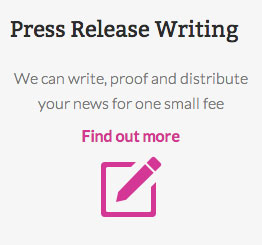FREE PR Tips guaranteed to bag your business valuable Press Coverage
Arranging a public relations campaign can be relatively easy, assuming you have a huge budget, cooperative staff, and a budget to wine and dine media moguls. However, what about the businesses who do not have the staff, or the income, to promote a lavish campaign?
This is the dilemma that most start-up businesses face within the first year of trading. You have the passion, the drive, and the product but these 'strengths' are dwarfed by the lack of monetary resources available, which could truly push a product and attract readers.
Nevertheless, you should remember that marketing your product is just as important as the product itself. You can have the best product in the world, but if the right people are unaware of it, the marketing can prove useless and costly. The goal is to 'genuinely' target or persuade your customers, investors, and stakeholders to trust and pledge their energies and expertise to your product over a long-term capacity. There is little point in discussing the available PR options for a business in general, as there are so many. Instead focus on what can be realistically achieved, especially if you have just started in business. Put on your public relations hat, as from now on you will be wearing it wherever you go.
Network Like a Pro
Plain and simple, you must conduct research. Get involved with as many events as possible, and as often as possible. Not only will this help you build contacts, but also create brand awareness. Best of all, there are a long list of free events, meet-ups, networking groups, and conferences to attend, whatever your sector. Conduct a few searches through Google and see what comes up. They do not have to be sector specific either. As a start-up business, you will likely need an accountant, suppliers, and investors—to name a few. Working with such entities is far more beneficial when you know them personally.
Treat everyone you meet as a potential client, and hand out as many business cards as possible. Take the business contact details of others and stay in regular contact. By far the easiest way to do this is through social media outlets like Twitter, Facebook, and LinkedIn, amongst others.
Staying in contact does not mean emailing the person or business when you need them. Maintain regular dialogue, even if it is not related to your sector or product/service. This helps build up a rapport for when you do need coverage.
Love Thy Brand
The company brand can determine the future of your product or service. If you do not resolutely believe in it, do not expect others to. The way you speak (both verbal and written), your attitude, and the love of your product or service must shine through during communications with the media. Show genuine enthusiasm and excitement, as journalists and bloggers can see through desperation and false agendas.
Strategies
Conduct research beforehand to determine your targets. Distributing a press release about 'a new mobile app that helps children learn faster' is useless to a sports journalist. Choose the relevant people within the media who have previously covered similar stories or topics. In the above example of press release, the target sectors may include consumer technology, education, and the health sector.
Any worthwhile PR distribution service will allow you to specify the sector you wish to target when creating a press release.
Agency VS Manual
This is worth mentioning, even if only brief. PR agencies equate to convenience, nothing more. Although they can be helpful, they do not guarantee tangible results either.
As a start-up business, keeping costs to a minimum is crucial. However, if you plan to put in the work creating and researching your news campaign, there is no reason why you cannot achieve the same results at a fraction of the price. The downside in deciding not to use an agency is the media contact lists. Then again, these contact list services can be accessed through press release distribution websites like Pressat.co.uk.
A useful tip when creating your press release is to focus on trending and associative writing. A limited fund and reach means that your release must get its point across during the first read. An effective way to ensure this happens is to link your story with a 'current popular topic'. If your product can somehow influence a topic, positively or negatively if you're brave enough, currently popular with the media and public, it will most likely be accepted.







